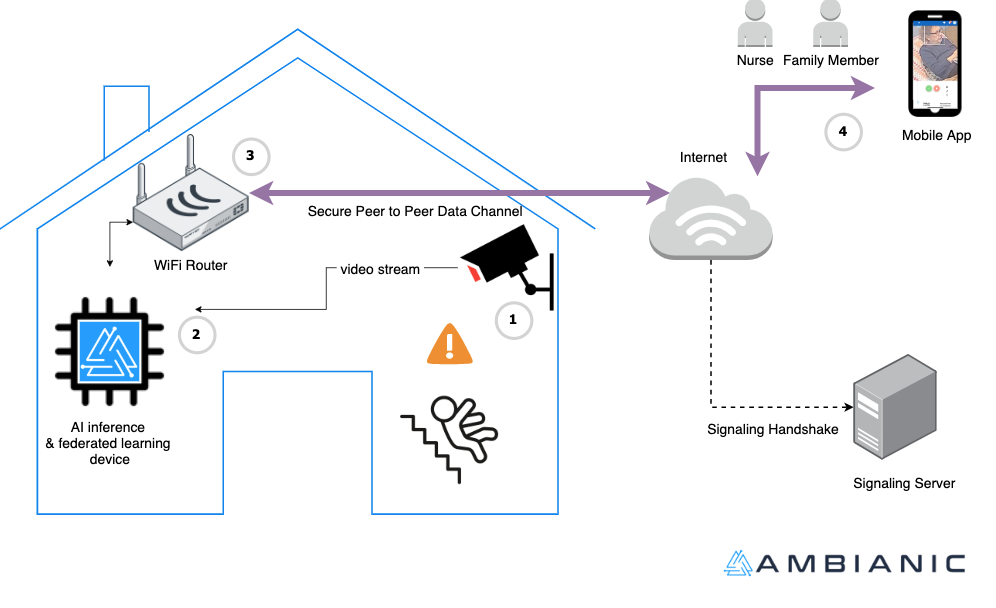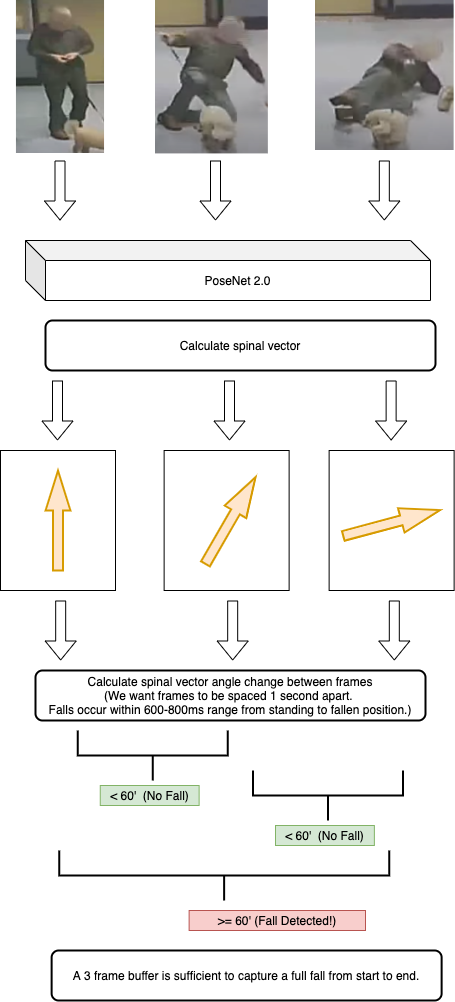Standalone Python ML library for people fall detection based on Tensorflow and PoseNet 2.0.
Project description
Person Fall Detection
This repo is the new home of the fall detection model used in Ambianic Edge. We moved the code over from the ambianic-edge repo and made it available as a standalone library in order to foster further research and use outside the Ambianic.ai project.
What's included in this repo
- Standalone Python ML library for people fall detection based on Tensorflow and PoseNet 2.0.
- Python source code
- Jupyter Notebook to interactively test and experiement with the model
- CI & test suite
- Training and testing data sets
- Third party ML models used as building blocks
- Wheel package published on PyPi
Project motivation
For many adults, one of the most difficult decisions to make is how to care for an elderly parent or relative that needs assistance. The AARP has found that almost 90% of folks over the age of 65 prefer to remain independent by living out their golden years at home.
Whether living alone or with family members, elderly parents need constant monitoring. Why? This is because as they age, their risk to potentially life-threatening accidents increases.
In fact, a slew of researches reveal that seniors are more prone to fall than other age classes. Falls are the leading cause of fatal injury and the most common cause of nonfatal trauma-related hospital admissions among older adults.
In a recent guest blog post for Linux Foundation AI & Data we shared the background of the problem and current market solutions.
How it works
The Fall Detection algorithm fits well with the Ambianic framework of privacy preserving AI for home monitoring and automation. The following diagram illustrates the overall system architecture. End users install an Ambianic Box to constantly monitor a fall risk area of the house. If a fall is detected, family and caregivers are instantly notified that their loved one has fallen down.
In the current design we use a combination of the PoseNet 2.0 Deep Neural Network model and domain specific heuristics to estimate a fall occurance. The following diagram illustates the main steps.
Experiment
Experiment with the fall-detection module using simple script, jupyter-notebook or command line input(CLI) by feeding 2 or 3 images. The input images should be spaced about 1 second apart.
Run a Python Script
python3 demo-fall-detection.py
Jupyter Notebook
Source code of the Demo.ipynb notebook is available in this repo.
To run an interactive version on binder, click here.
For more information how to work with Jupyter Notbooks on Github, see this document.
Execute the below command for CLI usage
To test fall-detection using the CLI for 2 images:
python3 demo-fall-detection-cmd.py --image_1 Images/fall_img_1.png --image_2 Images/fall_img_2.png
To test fall-detection using the CLI for 3 images:
python3 demo-fall-detection-cmd.py --image_1 Images/fall_img_1.png --image_2 Images/fall_img_2.png --image_3 Images/fall_img_3.png
Limitations
Based on testing and user feedback we are aware of the following limitations for the Fall Detection algorithm:
- Distance from monitored area: Optimal about 15-25 feet (5-8 meters). The camera has to be able to see the whole person in standing position before the fall and fallen position after the fall. If the camera is not able to see a substantial part of the body, the Fall Detection model may not have sufficient confidence in its estimation of the situation.
- Camera hight: Optimal at about human eye level: about 4-7ft (1-2 meters). If the camera is angled too low or too high overhead , the PoseNet model is not able to estimate body keypoints with confidence.
- Lighting condition: Good lighting is required for optimal performance. Dim light reduces PoseNet's confidence in keypoint estimates.
- Single person: The model is optimized for situation when a person is home alone. If there are multiple people in the camera view, that may confuse the model and lead to false fall detections.
- No clutter: The model performs best when the area being monitored is relatively clear of various small objects. Areas cluttered with objects may confuse the model that some of these objects look like people.
- Occlusions: The model suffers when the person falls behind furniture (e.g. a table or a chair) that blocks the camera from seeing a substantial part of the body.
Future work
Updating pose detection to MoveNet
The current version of the Fall Detector uses PoseNet Mobilnetv1. We have done research with a more recent MoveNet model from Google AI and published a comparison between PoseNet and MoveNet on fall data.
There are other recent models such as BlazePose 3D that have yet to be benchmarked on fall data. We welcome contributions from other researchers.
As we work with families and caregivers to test the system in real world scenarious, we expect to develop better intuition for the key factors that determine a fall in a sequence of video frames.
Moving towards on-device transfer learning for fall classification
Eventually we expect to replace some of the current heuristics with learned models that are able to more precisely distinguish between true falls and non-falls (e.g. bending over or squating to tie shoes).
We began testing an on-device transfer learning approach using TFLite Model Maker. Here is our working notebook with early results.
Your Contributions
Ideas and constructive criticism are always welcome. Feel free to join the discussion on Slack, open a github issue or a PR draft.
Project details
Release history Release notifications | RSS feed
Download files
Download the file for your platform. If you're not sure which to choose, learn more about installing packages.
Source Distribution
Built Distribution
Hashes for falldetect-1.0.9-py3-none-any.whl
| Algorithm | Hash digest | |
|---|---|---|
| SHA256 | 3f7992f27708e0b29e82b31ffca96d28fff39ba844919a7ddace667200d2dc6a |
|
| MD5 | 74c9895b9f3f5660406123d733cb56cf |
|
| BLAKE2b-256 | 9a63c24de4c826ca4a04d5ef69adbcb2812f182a97916ef0182dc537108b14e5 |




















